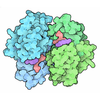[English] 日本語
 Yorodumi
Yorodumi- EMDB-37952: Human erythrocyte catalase with SLS as additive during cryo-EM gr... -
+ Open data
Open data
- Basic information
Basic information
| Entry |  | |||||||||
|---|---|---|---|---|---|---|---|---|---|---|
| Title | Human erythrocyte catalase with SLS as additive during cryo-EM grid preparation | |||||||||
 Map data Map data | Relion sharpened full map | |||||||||
 Sample Sample |
| |||||||||
 Keywords Keywords | Catalase / Oxidoreductase / heme / NADP | |||||||||
| Function / homology |  Function and homology information Function and homology informationresponse to phenylpropanoid / aminoacylase activity / catalase complex / hemoglobin metabolic process / response to inactivity / cellular detoxification of hydrogen peroxide / response to L-ascorbic acid / response to ozone / oxidoreductase activity, acting on peroxide as acceptor / response to light intensity ...response to phenylpropanoid / aminoacylase activity / catalase complex / hemoglobin metabolic process / response to inactivity / cellular detoxification of hydrogen peroxide / response to L-ascorbic acid / response to ozone / oxidoreductase activity, acting on peroxide as acceptor / response to light intensity / catalase / UV protection / response to fatty acid / response to vitamin A / catalase activity / peroxisomal membrane / ureteric bud development / triglyceride metabolic process / Detoxification of Reactive Oxygen Species / antioxidant activity / peroxisomal matrix / positive regulation of cell division / response to vitamin E / response to hyperoxia / FOXO-mediated transcription of oxidative stress, metabolic and neuronal genes / response to cadmium ion / aerobic respiration / cholesterol metabolic process / response to activity / response to reactive oxygen species / hydrogen peroxide catabolic process / Peroxisomal protein import / response to lead ion / response to insulin / response to hydrogen peroxide / cellular response to growth factor stimulus / osteoblast differentiation / peroxisome / response to estradiol / NADP binding / secretory granule lumen / response to ethanol / ficolin-1-rich granule lumen / positive regulation of phosphatidylinositol 3-kinase/protein kinase B signal transduction / response to hypoxia / response to xenobiotic stimulus / intracellular membrane-bounded organelle / focal adhesion / heme binding / Neutrophil degranulation / negative regulation of apoptotic process / enzyme binding / protein homodimerization activity / protein-containing complex / mitochondrion / extracellular exosome / extracellular region / identical protein binding / membrane / metal ion binding / cytoplasm / cytosol Similarity search - Function | |||||||||
| Biological species |  Homo sapiens (human) Homo sapiens (human) | |||||||||
| Method | single particle reconstruction / cryo EM / Resolution: 3.7 Å | |||||||||
 Authors Authors | Yadav S / Vinothkumar KR | |||||||||
| Funding support |  India, 2 items India, 2 items
| |||||||||
 Citation Citation |  Journal: Acta Crystallogr D Struct Biol / Year: 2024 Journal: Acta Crystallogr D Struct Biol / Year: 2024Title: Factors affecting macromolecule orientations in thin films formed in cryo-EM. Authors: Swati Yadav / Kutti R Vinothkumar /  Abstract: The formation of a vitrified thin film embedded with randomly oriented macromolecules is an essential prerequisite for cryogenic sample electron microscopy. Most commonly, this is achieved using the ...The formation of a vitrified thin film embedded with randomly oriented macromolecules is an essential prerequisite for cryogenic sample electron microscopy. Most commonly, this is achieved using the plunge-freeze method first described nearly 40 years ago. Although this is a robust method, the behaviour of different macromolecules shows great variation upon freezing and often needs to be optimized to obtain an isotropic, high-resolution reconstruction. For a macromolecule in such a film, the probability of encountering the air-water interface in the time between blotting and freezing and adopting preferred orientations is very high. 3D reconstruction using preferentially oriented particles often leads to anisotropic and uninterpretable maps. Currently, there are no general solutions to this prevalent issue, but several approaches largely focusing on sample preparation with the use of additives and novel grid modifications have been attempted. In this study, the effect of physical and chemical factors on the orientations of macromolecules was investigated through an analysis of selected well studied macromolecules, and important parameters that determine the behaviour of proteins on cryo-EM grids were revealed. These insights highlight the nature of the interactions that cause preferred orientations and can be utilized to systematically address orientation bias for any given macromolecule and to provide a framework to design small-molecule additives to enhance sample stability and behaviour. | |||||||||
| History |
|
- Structure visualization
Structure visualization
- Downloads & links
Downloads & links
-EMDB archive
| Map data |  EMDB map data format EMDB map data format | |||
|---|---|---|---|---|
| Header (meta data) |  EMDB header EMDB header | |||
| Archive directory |  http://ftp.pdbj.org/pub/emdb/structures/EMD-37952 http://ftp.pdbj.org/pub/emdb/structures/EMD-37952 ftp://ftp.pdbj.org/pub/emdb/structures/EMD-37952 ftp://ftp.pdbj.org/pub/emdb/structures/EMD-37952 | HTTPS FTP |
-Validation report
| Summary document |  emd_37952_validation.pdf.gz emd_37952_validation.pdf.gz | 951 KB | Display |  EMDB validaton report EMDB validaton report |
|---|---|---|---|---|
| Full document |  emd_37952_full_validation.pdf.gz emd_37952_full_validation.pdf.gz | 950.6 KB | Display | |
| Data in XML |  emd_37952_validation.xml.gz emd_37952_validation.xml.gz | 15.9 KB | Display | |
| Data in CIF |  emd_37952_validation.cif.gz emd_37952_validation.cif.gz | 21.1 KB | Display | |
| Arichive directory |  https://ftp.pdbj.org/pub/emdb/validation_reports/EMD-37952 https://ftp.pdbj.org/pub/emdb/validation_reports/EMD-37952 ftp://ftp.pdbj.org/pub/emdb/validation_reports/EMD-37952 ftp://ftp.pdbj.org/pub/emdb/validation_reports/EMD-37952 | HTTPS FTP |
-Related structure data
| Related structure data | 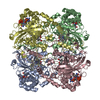 8wzhMC  37953  37954  37955  37956  39808  39809 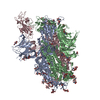 8wziC 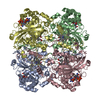 8wzjC 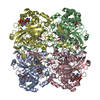 8wzkC 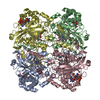 8wzmC C: citing same article ( M: atomic model generated by this map |
|---|---|
| Similar structure data | Similarity search - Function & homology  F&H Search F&H Search |
- Links
Links
| EMDB pages |  EMDB (EBI/PDBe) / EMDB (EBI/PDBe) /  EMDataResource EMDataResource |
|---|---|
| Related items in Molecule of the Month |
- Map
Map
| File |  Download / File: emd_37952.map.gz / Format: CCP4 / Size: 64 MB / Type: IMAGE STORED AS FLOATING POINT NUMBER (4 BYTES) Download / File: emd_37952.map.gz / Format: CCP4 / Size: 64 MB / Type: IMAGE STORED AS FLOATING POINT NUMBER (4 BYTES) | ||||||||||||||||||||
|---|---|---|---|---|---|---|---|---|---|---|---|---|---|---|---|---|---|---|---|---|---|
| Annotation | Relion sharpened full map | ||||||||||||||||||||
| Voxel size | X=Y=Z: 1.07 Å | ||||||||||||||||||||
| Density |
| ||||||||||||||||||||
| Symmetry | Space group: 1 | ||||||||||||||||||||
| Details | EMDB XML:
|
-Supplemental data
- Sample components
Sample components
-Entire : Catalase purified from human erythrocytes
| Entire | Name: Catalase purified from human erythrocytes |
|---|---|
| Components |
|
-Supramolecule #1: Catalase purified from human erythrocytes
| Supramolecule | Name: Catalase purified from human erythrocytes / type: complex / ID: 1 / Parent: 0 / Macromolecule list: #1 |
|---|---|
| Source (natural) | Organism:  Homo sapiens (human) Homo sapiens (human) |
| Molecular weight | Theoretical: 238 KDa |
-Macromolecule #1: Catalase
| Macromolecule | Name: Catalase / type: protein_or_peptide / ID: 1 / Number of copies: 4 / Enantiomer: LEVO / EC number: catalase |
|---|---|
| Source (natural) | Organism:  Homo sapiens (human) Homo sapiens (human) |
| Molecular weight | Theoretical: 59.836996 KDa |
| Sequence | String: MADSRDPASD QMQHWKEQRA AQKADVLTTG AGNPVGDKLN VITVGPRGPL LVQDVVFTDE MAHFDRERIP ERVVHAKGAG AFGYFEVTH DITKYSKAKV FEHIGKKTPI AVRFSTVAGE SGSADTVRDP RGFAVKFYTE DGNWDLVGNN TPIFFIRDPI L FPSFIHSQ ...String: MADSRDPASD QMQHWKEQRA AQKADVLTTG AGNPVGDKLN VITVGPRGPL LVQDVVFTDE MAHFDRERIP ERVVHAKGAG AFGYFEVTH DITKYSKAKV FEHIGKKTPI AVRFSTVAGE SGSADTVRDP RGFAVKFYTE DGNWDLVGNN TPIFFIRDPI L FPSFIHSQ KRNPQTHLKD PDMVWDFWSL RPESLHQVSF LFSDRGIPDG HRHMNGYGSH TFKLVNANGE AVYCKFHYKT DQ GIKNLSV EDAARLSQED PDYGIRDLFN AIATGKYPSW TFYIQVMTFN QAETFPFNPF DLTKVWPHKD YPLIPVGKLV LNR NPVNYF AEVEQIAFDP SNMPPGIEAS PDKMLQGRLF AYPDTHRHRL GPNYLHIPVN CPYRARVANY QRDGPMCMQD NQGG APNYY PNSFGAPEQQ PSALEHSIQY SGEVRRFNTA NDDNVTQVRA FYVNVLNEEQ RKRLCENIAG HLKDAQIFIQ KKAVK NFTE VHPDYGSHIQ ALLDKYNAEK PKNAIHTFVQ SGSHLAAREK ANL UniProtKB: Catalase |
-Macromolecule #2: PROTOPORPHYRIN IX CONTAINING FE
| Macromolecule | Name: PROTOPORPHYRIN IX CONTAINING FE / type: ligand / ID: 2 / Number of copies: 4 / Formula: HEM |
|---|---|
| Molecular weight | Theoretical: 616.487 Da |
| Chemical component information |  ChemComp-HEM: |
-Macromolecule #3: NADPH DIHYDRO-NICOTINAMIDE-ADENINE-DINUCLEOTIDE PHOSPHATE
| Macromolecule | Name: NADPH DIHYDRO-NICOTINAMIDE-ADENINE-DINUCLEOTIDE PHOSPHATE type: ligand / ID: 3 / Number of copies: 4 / Formula: NDP |
|---|---|
| Molecular weight | Theoretical: 745.421 Da |
| Chemical component information | 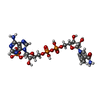 ChemComp-NDP: |
-Experimental details
-Structure determination
| Method | cryo EM |
|---|---|
 Processing Processing | single particle reconstruction |
| Aggregation state | particle |
- Sample preparation
Sample preparation
| Concentration | 3.4 mg/mL | ||||||
|---|---|---|---|---|---|---|---|
| Buffer | pH: 8 / Component:
| ||||||
| Grid | Model: Quantifoil / Material: GOLD / Mesh: 300 / Support film - Material: CARBON / Support film - topology: HOLEY / Pretreatment - Type: GLOW DISCHARGE / Pretreatment - Time: 60 sec. / Pretreatment - Atmosphere: AIR | ||||||
| Vitrification | Cryogen name: ETHANE / Chamber humidity: 100 % / Chamber temperature: 293 K / Instrument: FEI VITROBOT MARK IV / Details: Blot force, 0. |
- Electron microscopy
Electron microscopy
| Microscope | FEI TITAN KRIOS |
|---|---|
| Image recording | Film or detector model: FEI FALCON III (4k x 4k) / Detector mode: COUNTING / Digitization - Dimensions - Width: 4096 pixel / Digitization - Dimensions - Height: 4096 pixel / Number grids imaged: 1 / Average exposure time: 60.0 sec. / Average electron dose: 33.0 e/Å2 Details: Images were collected in movie mode at 40 frames per second. Total of 25 frames were saved for each movie. |
| Electron beam | Acceleration voltage: 300 kV / Electron source:  FIELD EMISSION GUN FIELD EMISSION GUN |
| Electron optics | C2 aperture diameter: 50.0 µm / Calibrated magnification: 130841 / Illumination mode: FLOOD BEAM / Imaging mode: BRIGHT FIELD / Cs: 2.7 mm / Nominal defocus max: 3.0 µm / Nominal defocus min: 1.8 µm / Nominal magnification: 75000 |
| Sample stage | Specimen holder model: FEI TITAN KRIOS AUTOGRID HOLDER / Cooling holder cryogen: NITROGEN |
| Experimental equipment |  Model: Titan Krios / Image courtesy: FEI Company |
- Image processing
Image processing
| Startup model | Type of model: INSILICO MODEL |
|---|---|
| Final reconstruction | Number classes used: 1 / Applied symmetry - Point group: D2 (2x2 fold dihedral) / Algorithm: BACK PROJECTION / Resolution.type: BY AUTHOR / Resolution: 3.7 Å / Resolution method: FSC 0.143 CUT-OFF / Software - Name: RELION (ver. 3.1) / Number images used: 33241 |
| Initial angle assignment | Type: MAXIMUM LIKELIHOOD |
| Final angle assignment | Type: MAXIMUM LIKELIHOOD |
 Movie
Movie Controller
Controller



